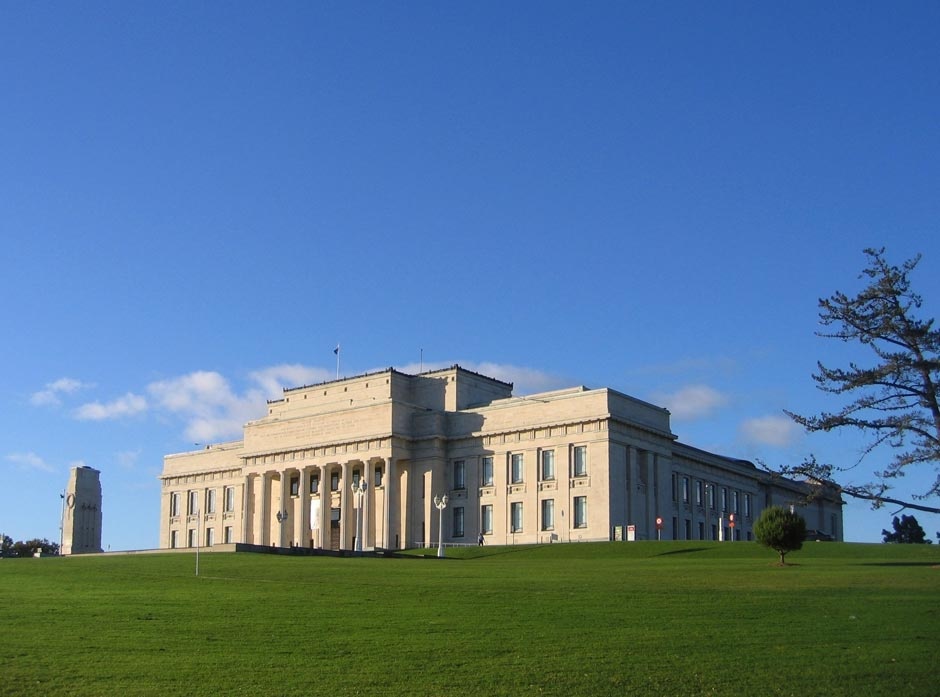
Auckland War Memorial Museum (1929)
A Parthenon on a hill of bitter memories
Between the wars, governors-general and other dignitaries unveiled hundreds of memorials to the dead of what everyone hoped had been the ‘war to end all wars’. It could be a touchy subject. Although people wanted to honour the fallen, they often disagreed about how and where to do it. Political fashions changed, too. Most Second World War memorials are ‘utilitarian’ – libraries, halls and community centres – but First World War sites are predominantly ‘inspirational’ – obelisks, cenotaphs and statues.
Auckland’s war memorial typified the complexities. The Auckland Institute had been planning a new museum on the Auckland Domain, for which it had got £25,000 from the government. But when Wellington’s Dominion newspaper complained, Auckland mayor J.H. Gunson tried to deflect criticism by making the museum a war memorial. He silenced the southerners but offended those veterans who felt that only a straight memorial would honour their comrades.
From his position on the citizens’ committee, museum curator T.E. Cheeseman counter-attacked quietly and persuaded his colleagues to stick with the museum. In October 1922 local firm Grierson, Draffin and Aimer won the design contest with an entry in the Greek Revival style that was almost de rigueur for memorials. Yet despite this ‘almost pedantic Classicism’, architectural historian Peter Shaw has called the monument, erected with Parthenon-like presence atop Te Wherowhero’s Pukekawa (‘hill of sorrows’), ‘a fervently nationalistic building’. In front the diggers got their Court of Honour and stone cenotaph, a replica of Luytens’s Whitehall one, sketched on the cheap by Draffin from newsreel footage.
Governor-General Sir Charles Fergusson opened the cenotaph on 28 November 1929 in a speech larded with classical references. He then declared the building open. During the 1930s Governors-General Bledisloe and Galway presided over enormous Anzac Day dawn parades at the Court of Honour. The parades continue to this day, while tourist buses occupy the hill for the rest of the year.
The Museum of New Zealand Te Papa Tongarewa in Wellington has replaced the Auckland War Memorial Museum as the most-visited in the country, but between 1994 and 1999 ‘Auckland’s Parthenon’ underwent a major redevelopment to make up for neglected maintenance and to freshen up displays and other services. More extensive alterations between 2003 and 2006 increased the museum’s floor area by 60%. The Grand Atrium project is dominated by a bowl-shaped building clad in Fijian kauri which hovers suspended within the former southern courtyard.
In recent years the museum has made the news for restructures, governance and staffing issues, and for imposing admission charges (labelled as ‘donations’).
Further information
This site is item number 87 on the History of New Zealand in 100 Places list.
Websites
- Memorials register – NZHistory
- Heritage New Zealand List entry
- Public buildings – Te Ara
- Memorials to the First World War – Te Ara
- Auckland Museum website
Books
- Grant Neill, ‘Auckland’s War Memorial Museum’, Historic Places in New Zealand, no. 39, 1992, pp. 16-19
- Jock Phillips and Chris Maclean, The sorrow and the pride, GP Books, Wellington, 1990
- Richard Wolfe, A noble prospect: 75 years of the Auckland War Memorial Museum building, Auckland War Memorial Museum, Auckland, 2004





Community contributions